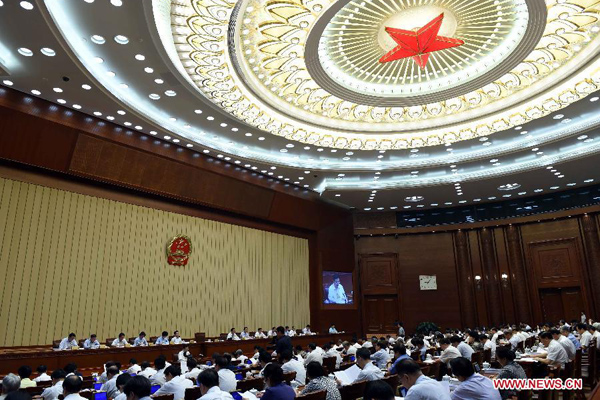China's vocational institutions train 130 mln

Zhang Dejiang, chairman of the National People's Congress (NPC) Standing Committee, the top legislature, delivers a report on vocational education during the third plenary session of the 15th meeting of the 12th National People's Congress (NPC) Standing Committee in Beijing, capital of China, June 29, 2015. (Xinhua/Rao Aimin)
BEIJING -- More than 130 million people have graduated from vocational schools and colleges in China since a law on vocational education was promulgated in September 1996, according to a report delivered by the top legislator on Monday.
Zhang Dejiang, chairman of the National People's Congress (NPC) Standing Committee, told the bimonthly session of the legislature that China has about 13,300 vocational schools and colleges, with 30 million students.
In 2014, there were about 18 million students in secondary vocational schools, compared with 12.7 million in 1996, he said.
The number of students enrolled at vocational colleges stood at 10 million last year, an increase from 1.23 million in 1996.
Zhang said vocational schools and colleges were the main training ground for technical workers.
Along with the increasing number of students, investment in vocational education has expanded in the past 19 years.
According to the report, the annual investment surged from 114.1 billion yuan (18.4 billion U.S. dollars) in 2006 to 345 billion yuan in 2013, posting an average increase of 17 percent annually.
A project initiated in 2009 to exempt students of secondary vocational schools from tuition has benefited 34.6 million people, it said.
Over the 19 years, a proficiency evaluation system has also been established, with five levels ranging from beginner, intermediate worker, to senior technician.
The report showed that more than 200 million people had participated in evaluations of vocational skills by the end of 2014, with about 160 million obtaining certificates.
Among the certificate holders, about 1.47 million were senior technicians, the most skilled workers, and some six million were technicians.
Since 2006, the government has stepped up efforts to improve vocational education in rural and poverty-stricken areas as well as places inhabited by ethnic minorities.
The report also said more than 40 million people coming from rural areas had received vocational training in the past decade before landing a city job.
Training of the disabled was also included in the vocational education plan. In the northwestern Gansu Province alone, the government set up 31 training centers for the group in the past five years, with 21,000 people having studied at the centers.
From March to May this year, Zhang headed a team to inspect the enforcement of the law on vocational education in six provinces as well as Chongqing municipality and Xinjiang Uygur Autonomous Region.
The inspectors, who were divided into four groups, held seminars with headmasters, teachers and human resources officials at about 70 institutions, training centers and enterprises on how to improve teaching.
This was the first time the NPC Standing Committee had organized a law enforcement inspection since the law took effect, the report noted.
It also pointed out that problems including unstable levels of investment and lack of experienced teachers are holding the sector back from further development.
The bimonthly session of the top legislature runs from June 24 to July 1.

Zhang Dejiang, chairman of the National People's Congress (NPC) Standing Committee, the top legislature, delivers a report on vocational education during the third plenary session of the 15th meeting of the 12th National People's Congress (NPC) Standing Committee in Beijing, capital of China, June 29, 2015. (Xinhua/Rao Aimin)
- Top legislature schedules session for December
- China's top legislator holds talks with president of Luxembourg parliament
- China's top legislator meets with French president
- China, Maldives pledge to enhance exchanges between legislative bodies
- Senior Chinese legislator meets Portugal's PSD delegation



